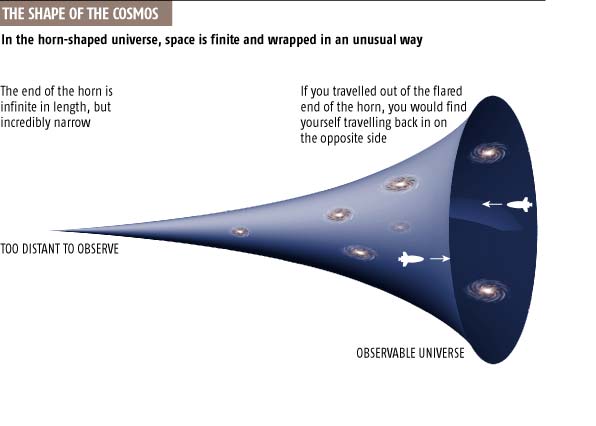Rerurn to Romy the Cat's Site
In the Forum: Horn-Loaded Speakers
In the Thread: Is horn a natural shape?
Post Subject: Is horn a natural shape?Posted by Romy the Cat on: 8/28/2009
fiogf49gjkf0d
Souse: New Scientist. 2004, by Stephen Battersby
Could the Universe be shaped like a medieval horn? It may sound like a surrealist's dream, but according to Frank Steiner at the University of Ulm in Germany, recent observations hint that the cosmos is stretched out into a long funnel, with a narrow tube at one end flaring out into a bell. It would also mean that space is finite.
Adopting such an apparently outlandish model could explain two puzzling observations. The first is the pattern of hot and cold spots in the cosmic microwave background radiation, which shows what the Universe looked like just 380,000 years after the Big Bang.
It was charted in detail in 2003 by NASA's Wilkinson Microwave Anisotropy Probe. WMAP found that the pattern fades on the largest scales: there are no clear hot or cold blobs more than about 60 degrees across.
Steiner and his group claim that a finite, horn-shaped Universe fits this observation. It simply does not have room to hold very big blobs.
The present-day volume of their model universe is nearly 1032 cubic light years. Back when the Universe was only 380,000 years old it would have been a fraction of that size, too small to allow big fluctuations.
Infinitely long
In the model, technically called a Picard topology, the Universe curves in a strange way. One end is infinitely long, but so narrow that it has a finite volume. At the other end, the horn flares out, but not for ever - if you could fly towards the flared end in a spaceship, at some point you would find yourself flying back in on the other side of the horn (see diagram).
Horn-shaped models were suggested in the 1990s to fit a similar anomaly seen by the COBE satellite, but Steiner's group is the first to show that this idea fits the WMAP data. In 2003, another group claimed that the Universe might be finite (New Scientist, 8 October 2003.)
In this group's model, space had a soccer ball-like shape. But the model has run into trouble. It should have left a clear signature on the microwave sky - a set of circles that mirror each other's spot patterns - but these circles do not seem to be there.
The horn universe is harder to pin down. It would also make matching circles, but the pattern depends on what part of the horn we are in. "Our published search for matching circles probably does not rule out the Picard topology," says Neil Cornish of Montana State University in Bozeman.
Little ellipses
And the idea has another advantage. In the flat space of conventional cosmology, the smallest blobs on microwave sky maps ought to be round. But they are not. "If you look at the small structures, they look like little ellipses," says Steiner. The curve of the horn-shaped universe could be just right to explain this. If you look at any little piece of the horn, it is saddle-shaped like a Pringles potato chip - curving down in one direction and up in the perpendicular one. This "negatively curved" space would act like a warped lens, distorting the image of round primordial blobs in a way that makes them look elliptical to us. Mathematicians can construct an infinite number of different kinds of negatively curved space, most of them with one or more horns, and many of which might fit the data, but the Picard topology is one of the simplest.
This model would force scientists to abandon the "cosmological principle", the idea that all parts of the cosmos are roughly the same. "If one happens to find oneself a long way up the narrow end of the horn, things indeed look very strange, with two very small dimensions," says Holger Then, a member of the team.
Statistical flukes
At an extreme enough point, you would be able to see the back of your own head. It would be an interesting place to explore - but we are probably too far from the narrow end of the horn to examine it with telescopes.
Both of the crucial observations are still ambiguous, however, and may be statistical flukes. Over the next year or so, WMAP and other experiments will test whether large blobs really are lacking and whether small ones really are elliptical.
If they are, then our Universe is curved like a Pringle, shaped like a horn, and named after a Star Trek character. You could not make it up.

The CatRerurn to Romy the Cat's Site